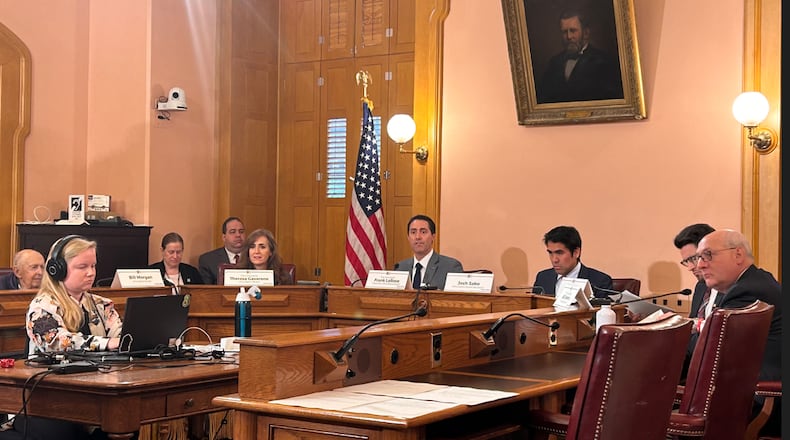In the book “Citizen Lawmakers” by David Schmidt, the battle was described as “the most bitter and momentous struggle known in the state for a generation. Every ruse and trick known to Big Business politicians was employed to frighten the people of Ohio from adopting the I&R. The whole corporate power of the state backed by Wall Street money and influence was thrown into the fight.”
Herbert Bigelow, the president of the constitutional convention and a longtime advocate for direct democracy, told the convention’s delegates: “We are forging the greatest tools democracy ever had.”
In the 1912 special election that followed the convention, the I&R amendment passed with 57.5% of the vote. Remember that percentage.
Now, with Issue 1 on the August ballot, state legislators are asking you to give up that hard-won power.
In the midst of the fallout from HB 6, the largest corruption scheme in Ohio history that would have included a $1.3 billion bailout; after the ECOT scandal, Ohio’s now-defunct online charter school that siphoned a billion dollars away from public schools and still owes the state $117 million; after former House Speaker Cliff Rosenberger resigned following an FBI probe into an alleged pay-to-play scheme with payday lenders — after all of this recently reported corruption, the Ohio Statehouse is asking you to relinquish a power specifically designed to keep corrupt politicians in check.
The process for the General Assembly to place a proposed amendment on the ballot will not change as a result of Issue 1, but the process for citizen-led initiatives will be made dramatically more difficult, a fact obfuscated by the ballot board’s decision to ignore Democrats’ request to add greater context to the ballot language that the Ohio Supreme Court just last week rejected.
“Voters are not likely to appreciate that the proposed procedures for petition-initiated constitutional amendments in S.J.R. 2 would fundamentally tip the balance of power away from the people and in favor of the General Assembly by severely diminishing Ohioans’ first reserved right under their state Constitution,” Ohio Supreme Court Justice Jennifer Brunner wrote in her partial dissent.
If Republicans such as Rep. Brian Stewart were sincere in their belief that putting this issue in front of Ohioans is the democratic approach, then they should have put it on the November ballot. Instead, they resurrected low-turnout August elections that they themselves just abolished, elections Frank LaRose himself has said “isn’t the way democracy is supposed to work.”
Claims about protecting our constitution from outside influence fall flat when the effort is itself supported by more than $1 million of ads paid for by Illinois billionaire Richard Uihlein.
Some proponents of Issue 1 have claimed that the state constitution should be as difficult to amend as the U.S. Constitution.
“If you look at the burden that exists to change the U.S. Constitution, for example, you’ll find it’s quite, quite complicated,” Gov. DeWine has said. “But it is a process that certainly calls for a few hoops to go over, or go through. So that’s why I’ll vote for it.”
There have been roughly 12,000 attempts to amend the United States Constitution since its creation. Of those, only 27 have been ratified — a success rate of about 0.002%. Nevermind that, unlike the federal constitution, state constitutions have been drafted and repeatedly rewritten and amended to empower popular majorities so that states can, in the words of former U.S. Supreme Court Justice Louis Brandeis, serve as responsive and experimental “laboratories of democracy.”
Increasing the passage requirement from a 50%+1 simple majority to 60%, in addition to its many other restrictions placed only on citizen-led initiatives, is a calculated move, by its proponents’ own admission, to get ahead of the reproductive rights campaign currently underway, as well as future challenges to Statehouse control, such as the ongoing redistricting fiasco. The 60% threshold is a much more challenging requirement that far fewer citizen-led initiatives would be able to meet, including the 57.5% vote that empowered Ohioans with the initiative and referendum processes in 1912. Issue 1, only required to pass by a simple majority, would no doubt struggle to meet its own requirement.
Expanding the 44-county signature requirement to an 88-county requirement is the final nail in the coffin that would make these efforts all but impossible for grassroots amendment campaigns.
Issue 1 is the latest power-grab from a Statehouse that openly defies orders of the Ohio Supreme Court regarding the state legislative redistricting process and routinely bats away a subservient governor. The system of checks and balances in Ohio’s three branches of government has broken down, and that means a less responsive, less representative and less transparent government for all of us.
Very simply, Issue 1 is about taking power away from you. Don’t disarm yourselves of the “greatest tools democracy ever had.”
Vote “No” on Issue 1.
